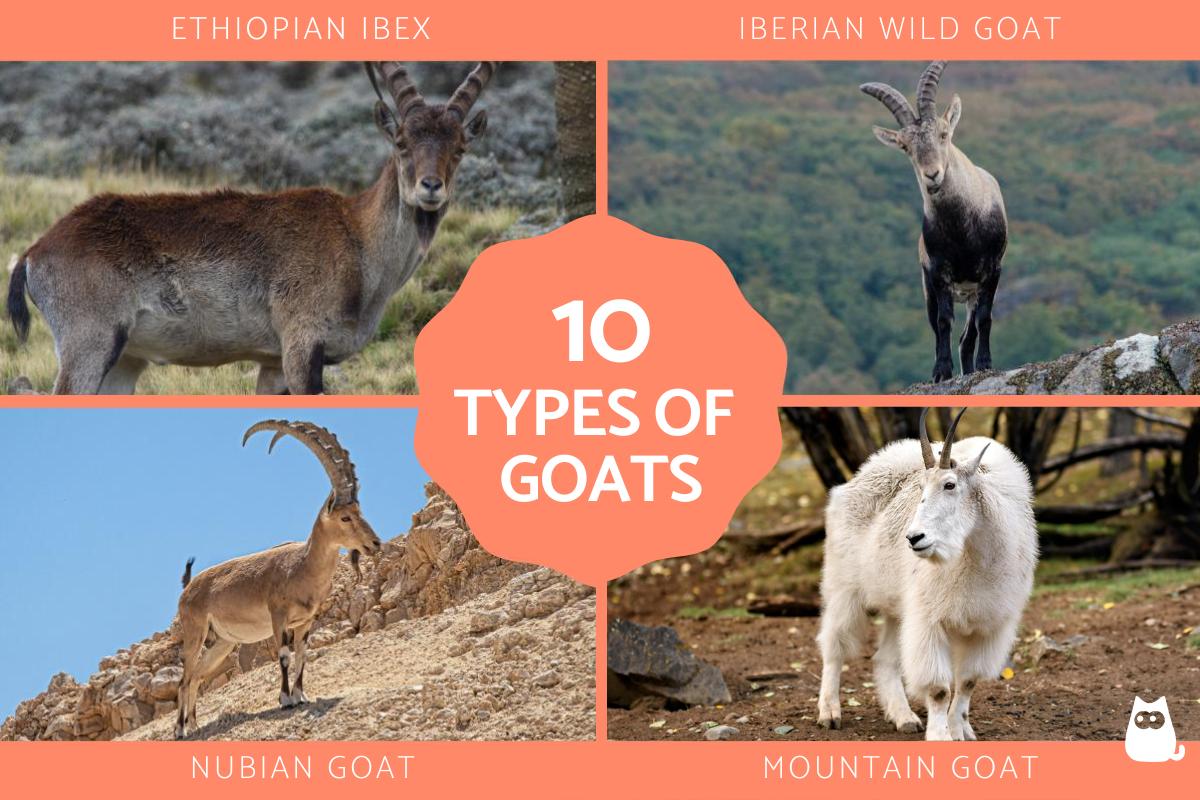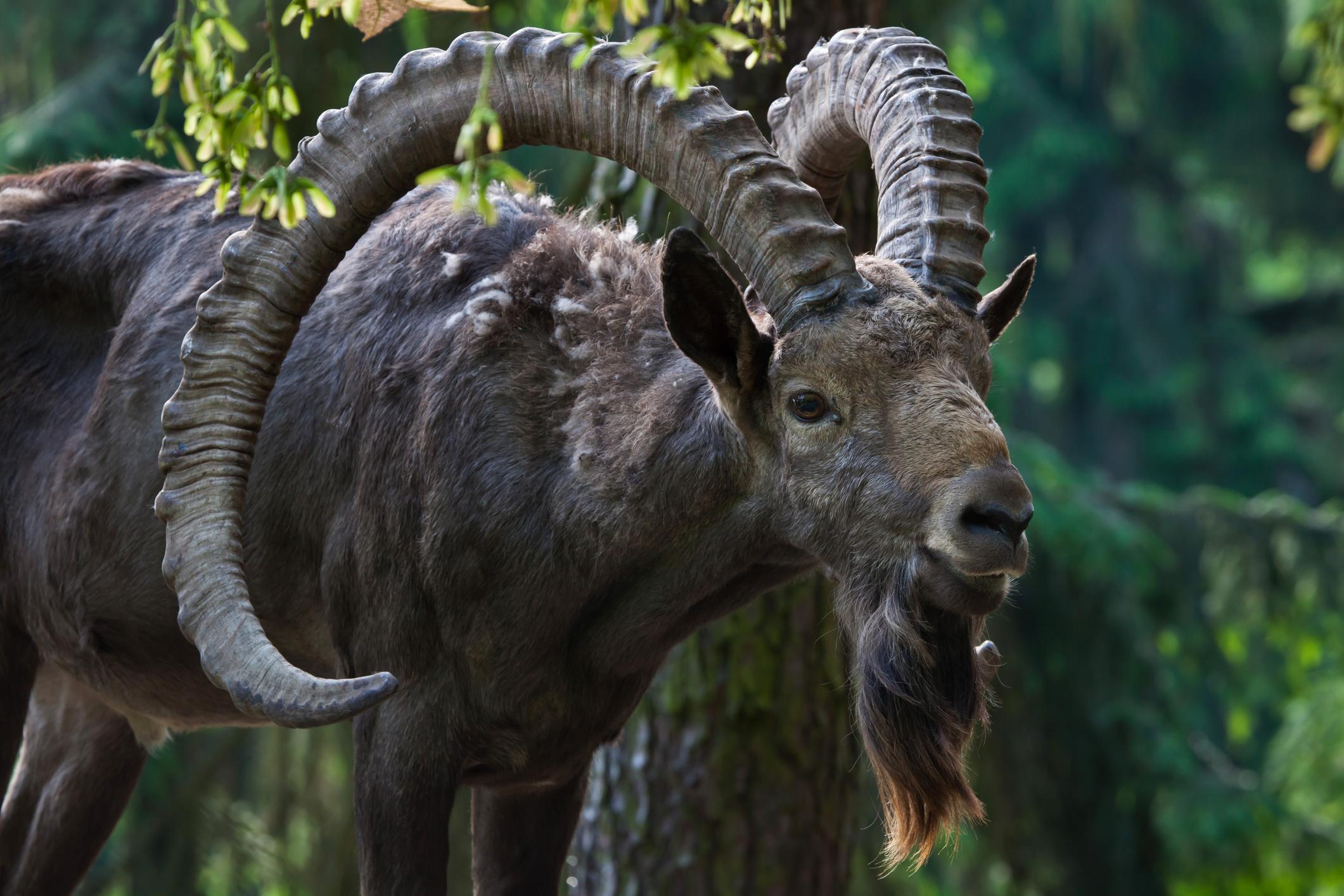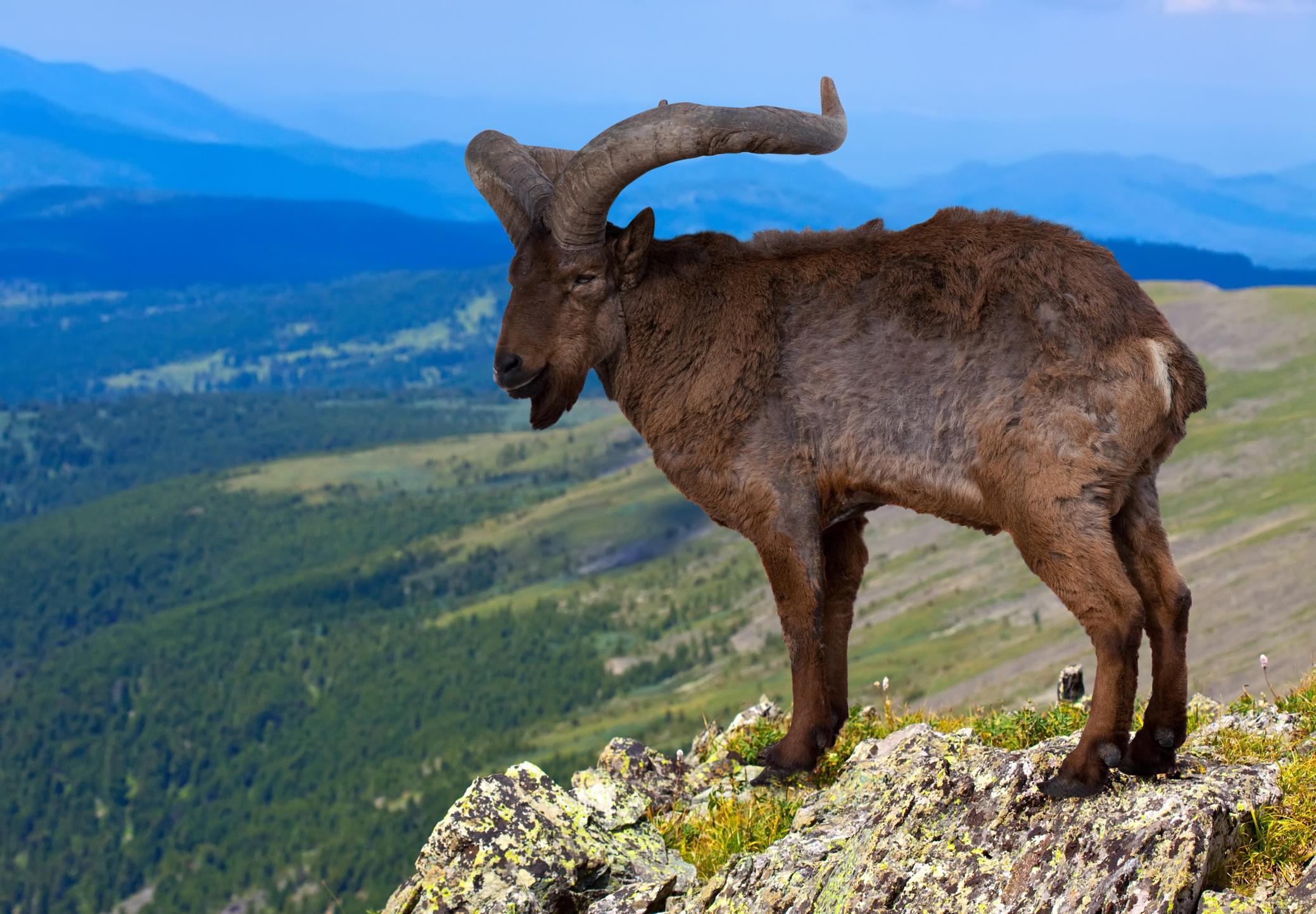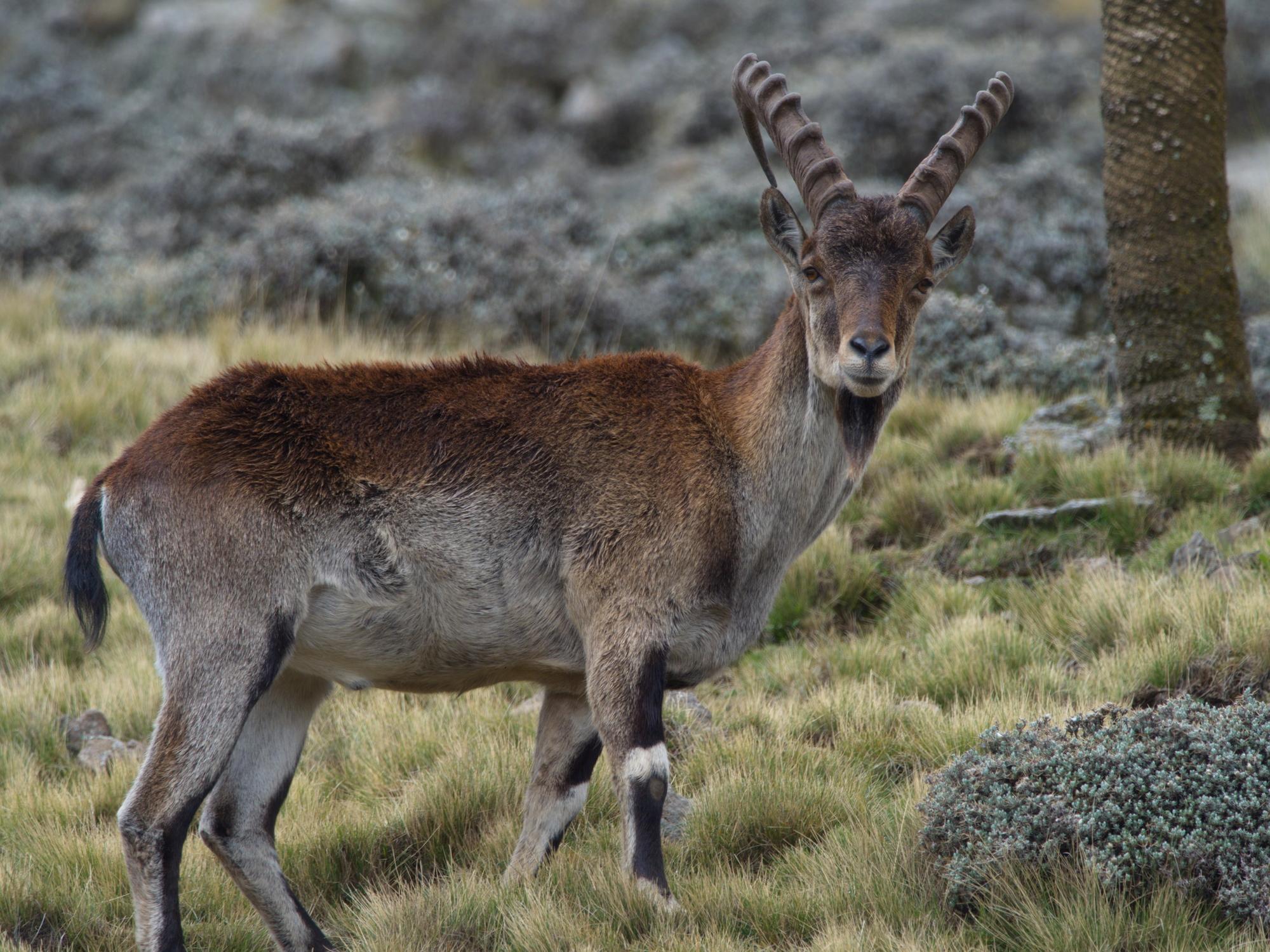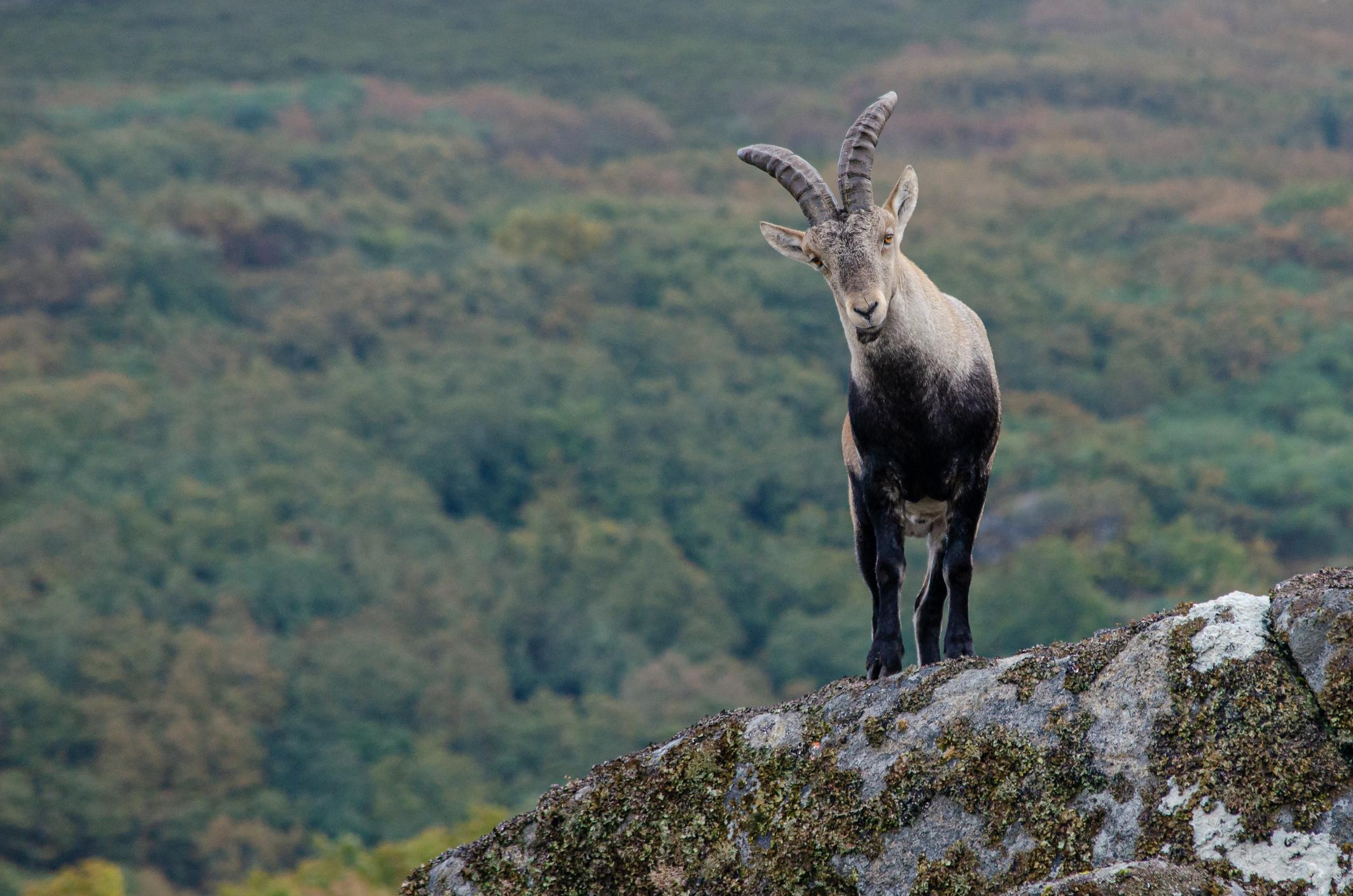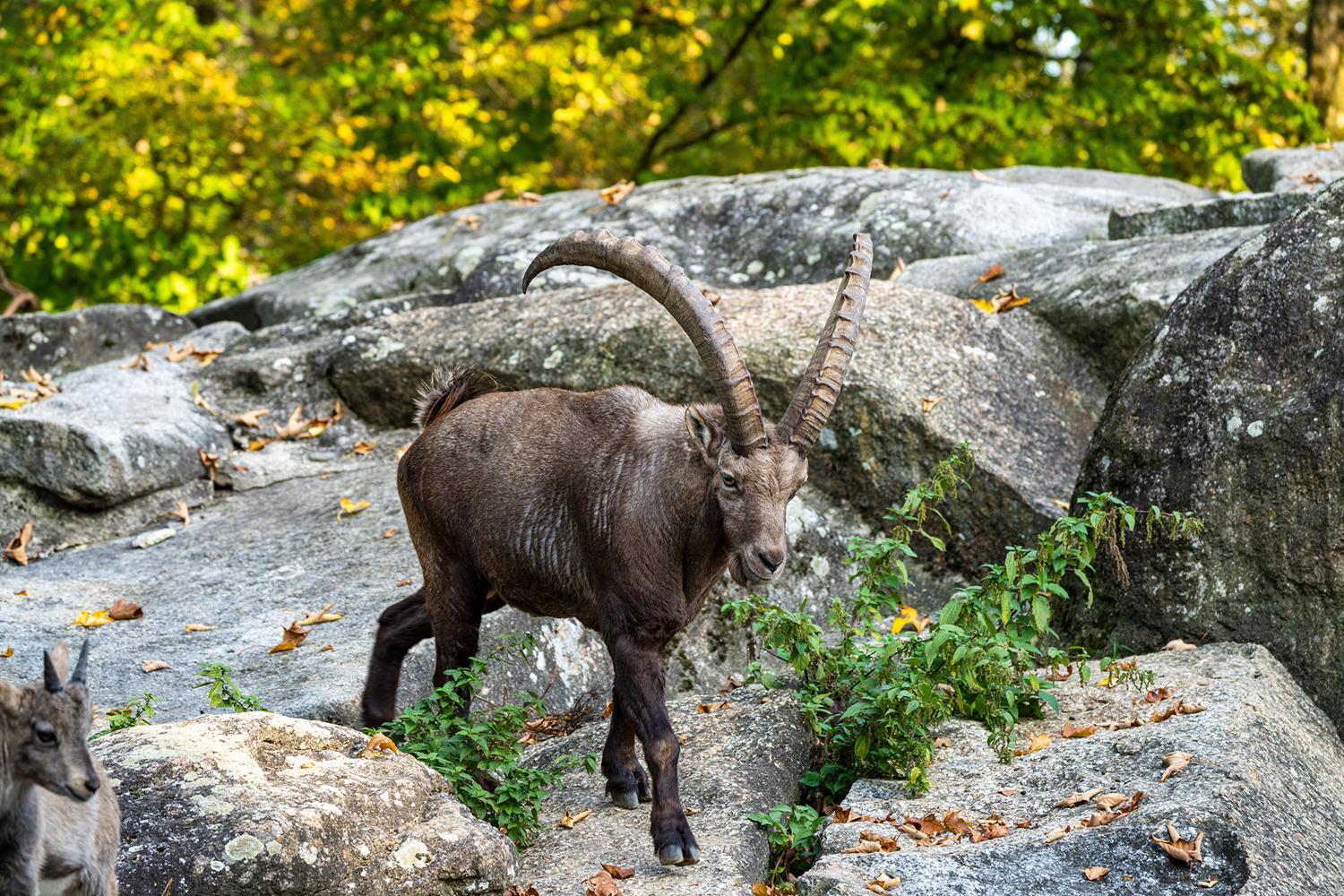Types of Goats - Comprehensive Guide


Goats are versatile and spirited ruminants that come in a dazzling array of breeds, each adapted to a unique niche. From the expansive plains to the rugged mountains, goats have thrived in a variety of landscapes, serving different agricultural and societal needs. This tapestry of goat breeds is woven with distinctive attributes, shaped by centuries of natural selection and human intervention. Coat color, horn shape, milk production, and climate suitability are just a few of the variations that enrich the world of goats.
In this AnimalWised article, we will explore the different types of goats, their most important and distinctive characteristics, and their conservation status.
- Siberian ibex (Capra sibirica)
- East Caucasian Tur (Capra cylindricornis)
- Ethiopian ibex (Capra walie)
- Iberian wild goat (Capra pirenaica)
- Nubian goat (Capra nubiana)
- Markhors (Capra falconeri)
- Western Tur (Capra caucásica)
- Ibex (Capra ibex)
- Wild goat (Capra aegagrus)
- Mountain goat (Oreamnos americanus)
Siberian ibex (Capra sibirica)
The Siberian ibex (Capra sibirica) is a wild goat species native to Central Asia. It is the largest member of the goat genus Capra, and is known for its impressive horns, which can grow up to 1 meter (3.3 feet) long.
Siberian ibex are large and heavily built goats, with males typically weighing between 30 and 100 kilograms (66 and 220 pounds). They have a thick coat of fur that varies in color from light brown to dark gray, with lighter tones on the lower regions of the body and a darker brown hue on the upper part of the body.
They inhabit high-altitude regions, ranging from 500 to 5,000 meters (1,640 to 16,404 feet). This makes them one of the few species of goats capable of enduring the extreme conditions of rocky mountainous terrains, showcasing their resilience in challenging habitats.
Siberian Ibex exhibit a social structure that involves the formation of mixed-sex groups. During the non-mating season, males and females live together in herds, but during the breeding season (rut), males establish their dominance through intense competitions.
The Siberian ibex is classified as "near threatened" by the International Union for Conservation of Nature (IUCN). The main threats to this species are habitat loss and hunting.
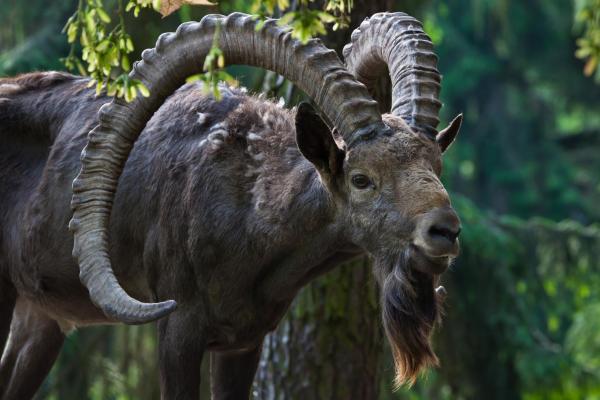
East Caucasian Tur (Capra cylindricornis)
The East Caucasian tur (Capra cylindricornis) is a mountain goat native to the Eastern Caucasus Mountains, spanning the regions of Azerbaijan, Georgia, and Russia. Unlike some other wild goat species with broader distributions, the East Caucasian Tur is endemic to a specific geographic region.
The East caucasian tur is a large and robust goat, with males weighing between 55 and 110 kilograms (121 and 243 pounds) and measuring 1.1 to 1.4 meters (3.6 to 4.6 feet) in length. Females are typically smaller, weighing between 35 and 50 kilograms (77 and 110 pounds).
This species possess a distinct horn structure. Their horns sweep backward, then curve sharply at the tips, resembling a lyre or cylindrical shape. Their fur is typically brown or gray, with lighter tones on the belly and legs.
This is a high-altitude species, inhabiting rocky terrains and alpine meadows ranging from 800 to 3,000 meters (2,624 to 9,842 feet) in elevation. This species is well-adapted to its challenging environment, with hooves that allow it to climb steep slopes and a thick coat of fur that protects it from the cold.
The East Caucasian tur is classified as "vulnerable" by the International Union for Conservation of Nature (IUCN). The main threats to this species include habitat loss and hunting.

Ethiopian ibex (Capra walie)
The Ethiopian ibex (Capra walie) is a mountain-dwelling species native to the landscapes of Ethiopia. The Simien Mountains National Park serves as the primary habitat for this species, with smaller populations found in the Bale Mountains and other mountainous regions of Ethiopia.
This species exhibits remarkable adaptability to the high-altitude environments of Ethiopia, thriving in elevations ranging from 1,500 to 4,500 meters (4,921 to 14,764 feet).
The Ethiopian ibex weights between 60 and 130 kg (132 to 287 lbs) and measuring 1.1 to 1.35 meters (3.6 to 4.4 feet) in length. Both male and female Ethiopian Ibex possess impressive, backward-curving horns. The horns of males are larger and more robust, with a distinctive arch. The Ethiopian Ibex's fur is typically brown or gray, with lighter tones on the belly and legs.
The Ethiopian Ibex holds cultural significance in Ethiopia, where it is featured in local folklore and traditions.
Environmental challenges, including habitat loss and hunting, have led to the classification of the Ethiopian Ibex as "vulnerable." Habitat alteration due to agricultural expansion and development projects threatens the Ethiopian Ibex's survival, while hunting is motivated by the desire to obtain its horns, considered a trophy by some. Urgent conservation efforts are essential to secure the future of this iconic species.
Which animal is known for its majestic horns, fluffy coat, and bleating call? Learn more about the key differences between goats and sheep in our other article.
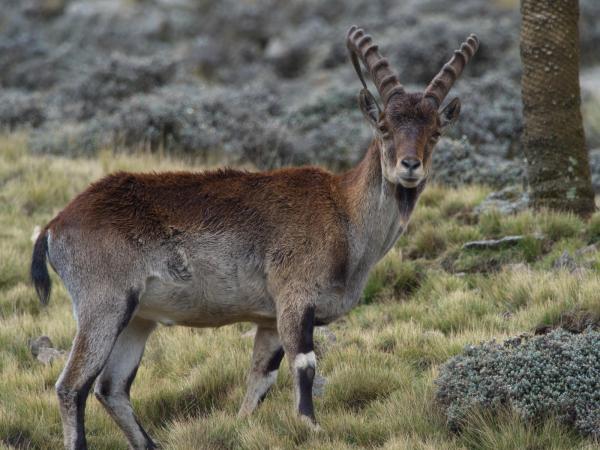
Iberian wild goat (Capra pirenaica)
The Iberian wild goat (Capra pirenaica) is a species native to the Iberian Peninsula. The Pyrenees Mountains serve as a stronghold for this species, with smaller populations found in other mountainous regions, such as the Sierra Nevada and the Sistema Central.
This species showcases a robust and agile build, weighing between 30 to 80 kg (66 to 176 lbs) and measuring 0.9 to 1.4 meters (2.95 to 4.59 feet) in length. Both males and females have backward-curving horns and their fur is typically brown or gray, with lighter tones on the belly and legs.
It exhibits remarkable adaptability to the varied environments of the Iberian Peninsula, thriving in elevations ranging from 200 to 2,000 meters (656 to 6,562 feet). Its habitat includes mountainous terrains, forests, and rocky cliffs. The Iberian Wild Goat is a skilled climber and can navigate these challenging landscapes with ease.
The Iberian wild goat comprises several subspecies, each adapted to specific ecological niches. Notable subspecies include:
- Beceite Ibex
- Gredos Ibex
- Sierra Nevada Ibex
- Ronda Ibex.
These subspecies exhibit variations in size, horn shape, and coat color.
Environmental challenges, including habitat loss, hunting, and diseases, have led to the classification of the Iberian Wild Goat as "near threatened." Conservation efforts have been implemented to protect and preserve the Iberian Wild Goat. Some subspecies, like the Beceite and Gredos Ibex, have experienced successful conservation programs that resulted in population recoveries.
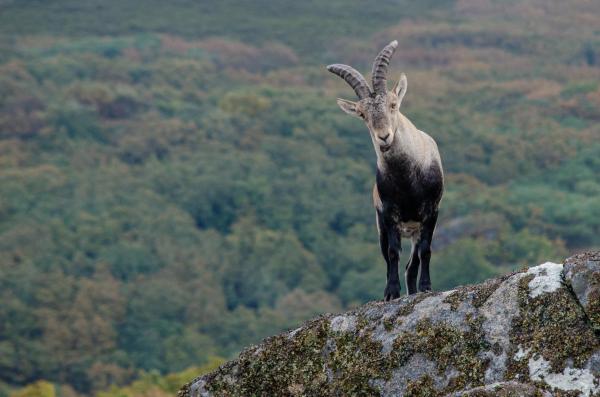
Nubian goat (Capra nubiana)
The Nubian goat (Capra nubiana) is native to Egypt, Jordan, Oman, Saudi Arabia, Sudan and Yemen. The breed was introduced to Europe and North America in the late 19th century, and it quickly gained popularity due to its many desirable traits. Today, the Nubian Goat is one of the most popular goat breeds in the world, and it is found in virtually every continent.
It lives in rocky and desert mountains, hills and steep slopes, with elevations of up to 3,000 meters above sea level, although it can also be found in low areas.
The Nubian Goat is known for its distinctive appearance, characterized by long, pendulous ears and a convex facial profile. Nubian Goats have a short to medium coat, which can be any color or pattern. Some of the most common coat colors include white, brown, black, and tan.
Nubian Goats are also known for their large size, with males typically weighing between 65 and 110 kilograms (143 and 243 pounds) and females weighing between 55 and 100 kilograms (121 and 220 pounds).
The Nubian Goat is a highly adaptable breed that can thrive in a variety of climates. Nubian Goats are well-suited for both dairy and meat production. Nubian Goat milk is known for its high butterfat content, making it ideal for cheese and yogurt production. Nubian Goat meat is also highly prized for its tenderness and flavor. In addition to its dairy and meat production capabilities, the Nubian Goat is also a popular choice for companion animals. Nubian Goats are known for their friendly and intelligent disposition.
While the Nubian Goat is a popular breed, it faces certain challenges related to breeding practices and conservation. One of the main challenges is the emphasis on breeding for high milk production. This can lead to health problems in female Nubian Goats, such as udder infections and mastitis.
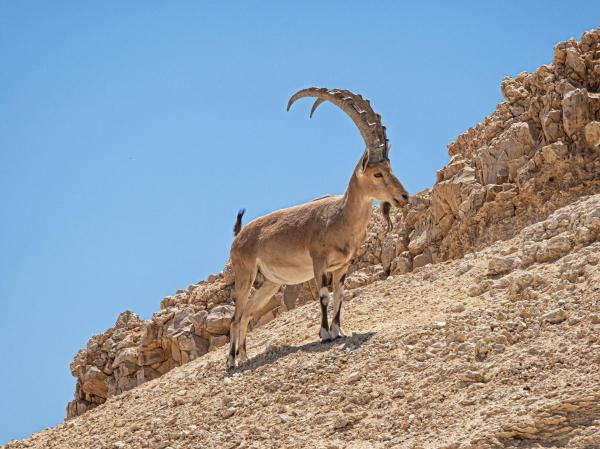
Markhors (Capra falconeri)
Markhors (Capra falconeri) are wild goats known for their distinctive spiral-shaped horns. They are found in the mountainous regions of Central Asia, from the Himalayas to the Hindu Kush.
They are large goats, with males weighing up to 110 kilograms (243 pounds) and females weighing up to 70 kilograms (154 pounds). They have thick fur that is typically brown or gray in color. Males have large spiral-shaped horns that can grow to be over 1 meter (3.3 feet) long. Females have smaller, less curved horns.
This species lives in a variety of habitats, including alpine meadows, rocky slopes, and cliffs. They are well-adapted to their high-altitude environment. Their hooves are sharp and strong, which allows them to climb steep slopes with ease. Their thick fur protects them from the cold climate.
Markhors are listed as "least concern" on the IUCN Red List of Threatened Species. However, they face a number of threats, including habitat loss, poaching, and competition from domestic livestock.
Did you know that goats are ruminant animals? Learn more about ruminant animals and their unique digestive system in our other article.

Western Tur (Capra caucásica)
The Western tur (Capra caucasica) is a wild goat species native to the Caucasus region, in countries such as Russia, Georgia, and Azerbaijan. The Greater Caucasus Mountains serve as the primary habitat for this species, with smaller populations found in the Lesser Caucasus Mountains. The Caucasus region is characterized by a diverse topography, with steep mountain peaks, deep valleys, and glaciers.
Weighing between 60 to 110 kg (132 to 243 lbs) and measuring 1.2 to 1.5 meters (3.9 to 4.9 feet) in length, the Western tur showcases a robust build and distinctive backward-curving horns. Males typically have larger horns than females. The Western tur's fur is typically brown or gray, with lighter tones on the belly and legs. Both males and females have a dark beard.
The Western tur is known for its agility and climbing abilities. It navigates steep cliffs and rocky slopes with ease, utilizing its specialized hooves.
The Western tur is classified as "near threatened" by the International Union for Conservation of Nature (IUCN). The main threats to this species include habitat loss and poaching. Habitat loss is primarily driven by agricultural expansion and development projects, while poaching is motivated by the desire to obtain the animal's horns and meat.

Ibex (Capra ibex)
The ibex (Capra ibex) is a wild goat species that thrives in the rugged landscapes of Europe, Asia, and North Africa. Roaming the diverse terrains of the Alps, Carpathians, Himalayas, and beyond, the Ibex has established its presence in countries such as Switzerland, Italy, France, and Spain. The ibex is also found in the Altai Mountains of Central Asia, and in the Atlas Mountains of North Africa. The Ibex's geographical distribution is shaped by its preference for mountainous habitats with steep cliffs and rocky slopes.
Males typically weigh between 90 to 130 kg (198 to 286 lbs) while females are generally smaller, with weights ranging from 40 to 60 kg (88 to 132 lbs).
Males have distinctive curved horns, which can grow up to one meter in length. Females also have horns, but they are smaller and less curved than the horns of males. The ibex's fur is typically brown or gray, with lighter tones on the belly and legs.
Some populations of Ibex engage in seasonal migrations, moving between higher and lower elevations in response to changing weather and resource availability. These migrations are often influenced by factors such as temperature, snowfall, and food availability in different altitudinal zones.
The ibex is classified as "least concern" by the International Union for Conservation of Nature (IUCN). However, the ibex faces a number of challenges, including habitat loss, poaching, and climate change. Habitat loss is primarily driven by agricultural expansion and development projects, while poaching is motivated by the desire to obtain the animal's horns and meat. Climate change is also a threat to the Ibex, as it can lead to changes in vegetation patterns and snow cover, which can impact the animal's food availability and habitat quality.
Did you know that goats have some of the most incredible horns in the animal kingdom? Discover other animals with fascinating horns in our other article.

Wild goat (Capra aegagrus)
The wild goat (Capra aegagrus) is a wild species native to Asia and the Middle East. The wild goat inhabits a diverse range of habitats, from the mountainous regions of Turkey and Iran to the arid landscapes of the Arabian Peninsula. It is also found in the Caucasus, Central Asia, and Afghanistan.
The wild goat is a medium-sized goat with a robust build. Adult males typically weigh between 50 to 110 kg (110 to 243 lbs) and larger individuals may occasionally exceed these weights. Adult females are generally smaller and lighter than males, with weights ranging from 30 to 65 kg (66 to 143 lbs). Both males and females have curved horns, but the horns of males are larger and more curved. The wild goat's fur is typically brown or gray, with lighter tones on the belly and legs.
Wild goats are renowned for their agility and climbing prowess. Equipped with specialized hooves, they traverse steep and rocky terrain with ease. Their ability to access elevated areas aids in evading predators and finding suitable forage in challenging environments.
The Wild Goat is classified as "least concern" by the International Union for Conservation of Nature (IUCN).
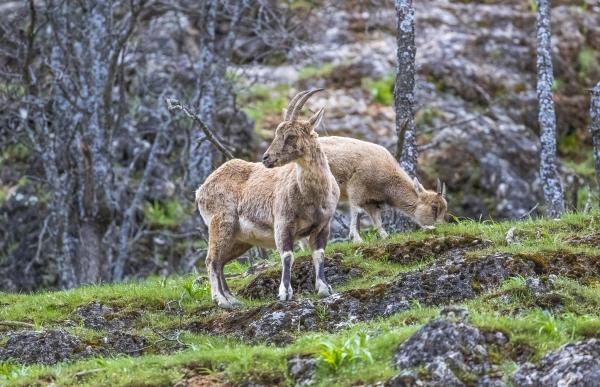
Mountain goat (Oreamnos americanus)
The mountain goat (Oreamnos americanus) is a wild species native to North America. From the Rocky Mountains to the Cascade Range, the Mountain Goat thrives in challenging terrains. It is found in the mountains of Canada, the United States, and Alaska.
Mountain goats are well-adapted to high-altitude habitats, often inhabiting elevations exceeding 3,000 meters (9,842 feet).
Adult male mountain goat can weigh between 90 to 140 kg (198 to 309 lbs) while adult female generally weigh between 55 to 80 kg (121 to 176 lbs). Both males and females have curved horns, but the horns of males are larger and more curved.
Mountain goats are known for their distinctive appearance, featuring a shaggy white coat that helps them blend into their alpine environments. Their coats provide insulation against cold temperatures and offer camouflage in the snowy landscapes they inhabit.
Unlike some other ungulates, mountain goats are generally non-migratory. They tend to stay within a specific range throughout the year, navigating their mountainous habitats with ease.
The mountain goat is currently classified as "least concern" by the International Union for Conservation of Nature (IUCN).
Did you know that goats are one of the highest-jumping animals in the world? Discover the other top contenders in our other article.
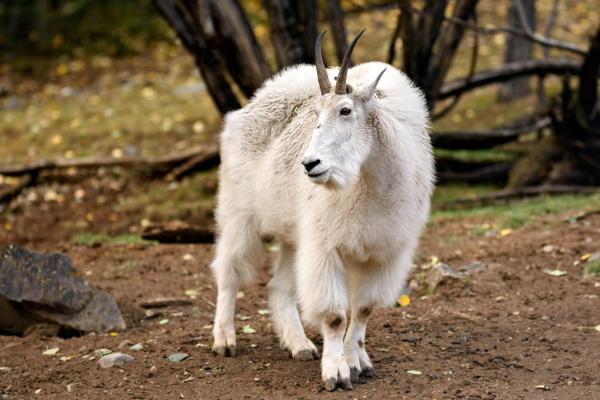
If you want to read similar articles to Types of Goats - Comprehensive Guide, we recommend you visit our Facts about the animal kingdom category.
- Animal Diversity Web (2020). Available at: https://animaldiversity.org/
- IUCN. (2022). The IUCN Red List of Threatened Species. Version 2022-1. Available at: https://www.iucnredlist.org





